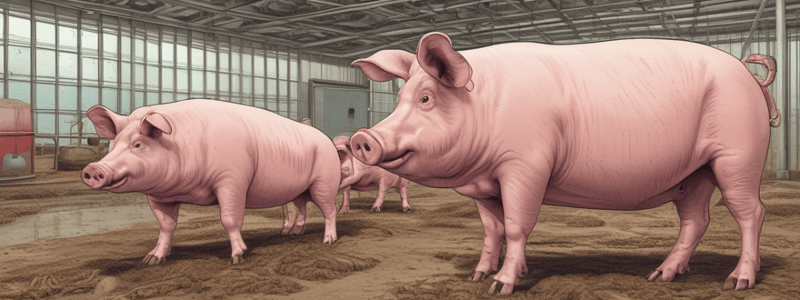Podcast
Questions and Answers
What is a sign of a sick pig?
What is a sign of a sick pig?
- Normal appetite
- Estrous phase
- Rapid, noisy breathing (correct)
- Vaccination program
Which of the following is a biosecurity measure to prevent disease transmission?
Which of the following is a biosecurity measure to prevent disease transmission?
- Limping
- Isolation of new animals (correct)
- Nursing phase
- Providing a well-balanced diet
What is an important aspect of good management for disease prevention?
What is an important aspect of good management for disease prevention?
- Maintaining a dirty and overcrowded environment
- Buying diseased stock from infected herds
- Providing a vaccination program
- Being alert for signs of disease and conditions that can cause stress (correct)
What is a key aspect of litter management in pig farming?
What is a key aspect of litter management in pig farming?
Which of the following is NOT a biosecurity risk?
Which of the following is NOT a biosecurity risk?
What is the primary reason why carcasses from boars or stags are not passed for use as human food?
What is the primary reason why carcasses from boars or stags are not passed for use as human food?
What is the term for the percentage yield of chilled carcass in relation to the weight of the live animal?
What is the term for the percentage yield of chilled carcass in relation to the weight of the live animal?
What is the characteristic of PSE pork that affects its ability to hold water?
What is the characteristic of PSE pork that affects its ability to hold water?
What is the classification of carcasses with unacceptable lean or bellies that are too thin?
What is the classification of carcasses with unacceptable lean or bellies that are too thin?
What is the advantage of dressing hogs in the 'Shipper style'?
What is the advantage of dressing hogs in the 'Shipper style'?
What is the normal heart rate for an animal?
What is the normal heart rate for an animal?
What is the main function of carbohydrates in animal nutrition?
What is the main function of carbohydrates in animal nutrition?
What is the significance of protein in animal nutrition?
What is the significance of protein in animal nutrition?
What is the normal temperature range for an animal?
What is the normal temperature range for an animal?
What is the role of minerals in animal nutrition?
What is the role of minerals in animal nutrition?
Study Notes
Signs of a Sick Pig
- Poor appetite, weakness, and lethargy are signs of a sick pig
- Rapid, noisy breathing, dry, crusty, or runny nose, limping, and changes in skin or developed abscesses are also signs
- Diarrhea is another indicator of illness
Biosecurity
- Herd additions, isolation of new animals, people movement, pig movement, and disease transmission on-farm are biosecurity concerns
- Vermin control, vehicles, water, and feed can also introduce diseases
Good Management for Disease Prevention
- Be alert for signs of disease and stress-causing conditions
- Provide clean, disinfected quarters with adequate ventilation and sunlight
- Ensure proper drainage and protect pigs from environmental stressors
- Practice rigid sanitation and manure removal, and provide a well-balanced diet
- Get accurate diagnosis of health problems immediately and avoid unnecessary stress
- Buy disease-free stock, isolate new animals, and follow a set vaccination program
- Be cautious of visitors and dispose of dead animals immediately
Reproduction
- Estrous cycle lasts 21 days
- Gestation period is 114 days
- Nursing lasts 3 weeks, growing 9 weeks, and finishing 9 weeks
- Processing takes 1 month, and conception to plate takes about 10.5 months
Litter Management
- Maintain body temperature and protect from injury
Health
- Normal temperature: 101-104°F
- Normal respiratory rate: 15-30 breaths per minute
- Normal heart rate: 59-86 beats per minute
Nutrition
- Six basic nutrients: protein, carbohydrates, lipids, minerals, vitamins, and water
Protein
- Provides essential amino acids
- Needed for growth and repair
- Forms muscles, internal organs, skin, hair, wool, feathers, hoofs, and horns
- Contains carbon, hydrogen, oxygen, and nitrogen (16%)
Carbohydrates
- Used as energy for body functions
- Largest part of an animal's feed supply
- Include sugars, starch, and cellulose
- Composed of carbon, oxygen, and hydrogen
Fats
- Concentrated source of energy (2.25 times carbohydrates)
- Form cholesterol, steroids, and other body compounds
- Found in every cell, affects skin and hair condition when absent
- Composed of carbon, oxygen, and hydrogen
Minerals
- Needed in nearly all body parts, primarily in bones and teeth
- Affect heartbeat and nerve transmission
- Divided into two groups: macro and micro minerals
Meat
- Quality grades consider lean meat quality and belly thickness
- Carcasses with unacceptable lean or bellies that are too thin are graded U.S. Utility
- Dressing percentage is the percentage yield of chilled carcass to live animal weight
- U.S. No. 1-4 grades have specific dressing percentages
Grading Exceptions
- Carcasses with thin muscling cannot grade US 1
- Carcasses with last rib back fat > 1.75 inch must grade US 4
- Carcasses with unacceptable quality must grade US Utility
PSE: Pale Soft Exudative Pork
- Causes meat to be very light gray in color
- Muscle is soft in texture, lacks ability to hold water, and exhibits separation between muscles
- Although PSE pork has acceptable nutritive value and taste, some protein and vitamin loss occurs
Studying That Suits You
Use AI to generate personalized quizzes and flashcards to suit your learning preferences.
Related Documents
Description
Learn to identify common signs of illness in pigs, such as poor appetite and rapid breathing, and understand the importance of biosecurity measures to prevent disease transmission.




